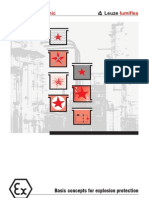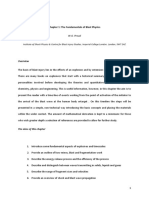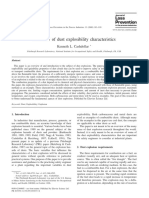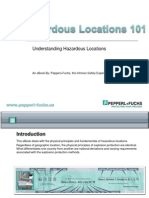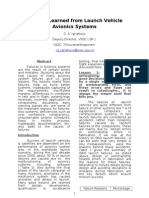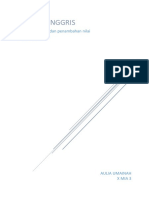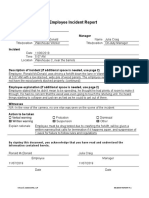0 ratings0% found this document useful (0 votes)
102 viewsPhilosophy of Fire Protection
Philosophy of Fire Protection
Uploaded by
Muros IntraThe document discusses philosophy of explosion protection. It begins by explaining that explosions occur when a fuel-air mixture is ignited, causing a rapid pressure increase and shockwave. The key steps for prevention are determining where explosive atmospheres may form using an area classification report, removing potential ignition sources by using explosion-protected equipment certified by approved test laboratories, and issuing a certificate of conformity once protection measures are in place and operators are trained. Maintaining explosion protection requires regular inspections of equipment and conditions.
Copyright:
© All Rights Reserved
Available Formats
Download as PDF, TXT or read online from Scribd
Philosophy of Fire Protection
Philosophy of Fire Protection
Uploaded by
Muros Intra0 ratings0% found this document useful (0 votes)
102 views2 pagesThe document discusses philosophy of explosion protection. It begins by explaining that explosions occur when a fuel-air mixture is ignited, causing a rapid pressure increase and shockwave. The key steps for prevention are determining where explosive atmospheres may form using an area classification report, removing potential ignition sources by using explosion-protected equipment certified by approved test laboratories, and issuing a certificate of conformity once protection measures are in place and operators are trained. Maintaining explosion protection requires regular inspections of equipment and conditions.
Original Description:
Fire Protection Guide
Copyright
© © All Rights Reserved
Available Formats
PDF, TXT or read online from Scribd
Share this document
Did you find this document useful?
Is this content inappropriate?
The document discusses philosophy of explosion protection. It begins by explaining that explosions occur when a fuel-air mixture is ignited, causing a rapid pressure increase and shockwave. The key steps for prevention are determining where explosive atmospheres may form using an area classification report, removing potential ignition sources by using explosion-protected equipment certified by approved test laboratories, and issuing a certificate of conformity once protection measures are in place and operators are trained. Maintaining explosion protection requires regular inspections of equipment and conditions.
Copyright:
© All Rights Reserved
Available Formats
Download as PDF, TXT or read online from Scribd
Download as pdf or txt
0 ratings0% found this document useful (0 votes)
102 views2 pagesPhilosophy of Fire Protection
Philosophy of Fire Protection
Uploaded by
Muros IntraThe document discusses philosophy of explosion protection. It begins by explaining that explosions occur when a fuel-air mixture is ignited, causing a rapid pressure increase and shockwave. The key steps for prevention are determining where explosive atmospheres may form using an area classification report, removing potential ignition sources by using explosion-protected equipment certified by approved test laboratories, and issuing a certificate of conformity once protection measures are in place and operators are trained. Maintaining explosion protection requires regular inspections of equipment and conditions.
Copyright:
© All Rights Reserved
Available Formats
Download as PDF, TXT or read online from Scribd
Download as pdf or txt
You are on page 1of 2
PHILOSOPHY OF
EXPLOSION
PROTECTION.
few minutes, now take the same mass of charcoal
pulverize and suspend it, if this were to be ignited
the entire mass will rapidly be oxidized leading to
the gasification of the fuel and rapid expansion of
gasses thus causing not a fire but a explosion as
describes before.
After having to sit through a tender meeting and
listen to venders and the client arguing over what
exactly the client required I felt so appalled at the
volume of misconceptions that I had to express
my understanding of explosion prevention. I hope
you find it of value and that it wil clear rather than
further deepening some of the chaos around
explosion prevention.
So the first step in explosion prevention would be
to determine where these explosive atmospheres
can or is likely to form. They can be highly
unpredictable so therefore a thorough study of the
plant needs to be done the results should be
captured in the form of a Area Classification
report to go with a AC Drawing that will indicate
graphically where the explosive atmospheres or
Zones are. The Zones are divided into three
ranging from Zone 0 to Zone 2 (for gases;
another 3-Zone structure applies to dusts). The
different Zones wil indicate how often the
explosive atmosphere is present with Zone 0
being constantly and Zone 2 only under abnormal
conditions, there is a popular believe that the
Zone 0 is more explosive than a Zone 2 this
however is not the case. Remember that the
Zones wil indicate where a fuel and oxygen
mixture forms and its frequency but if you had an
ignition of a explosive atmosphere the result is
expected to be similar, therefore the more severe
Zones only indicates how often a possible ignition
can be tolerated not how explosive the
atmosphere is.
First of all when I talk about explosion prevention
I have no concern with fire protection, for all I
care a fire will peacefully burn the plant to the
ground and hopefully not cause an explosion.
Explosions happen where there is a buildup of a
fuel and oxygen (air) mixture that if ignited would
rapidly oxidize and cause a shockwave of
expanding gasses. This shockwave wil cause the
pressure to increase so destroying any
obstructions. So as you surely know an explosion
can be much less romantic than just a fire even
though both can cause devastation in a plant. On
that note we are also not concerned about
explosives despite the resemblance. Explosives
carry the oxygen they need in their composition
and therefore dont necessary need additional
oxygen, only an ignition.
If one were for example to take a piece of
charcoal and ignite it, it wil surely burn from the
outside to the inside oxidizing all the fuel over a
After the size and frequency of the explosive
atmospheres was determined the next step wil be
to remove all the possible ignition sources. This
can be a real challenge as we know, any process
plant needs electrical equipment and control
instrumentation and they can all be potential
ignition sources. Lets start by discussing how
ignitions can happen, first of all a ignition source
need to add enough energy to the fuel/oxygen
mixture to start to bond or oxidize, this wil lead to
a exothermic reaction that wil in turn sustain the
process and cause the entire mixture oxidize. The
two main ignition sources are by a hot surface or
by an electrical spark (with enough energy). Since
the days of a Canary in a cage(or some other poor
creature) more effective techniques were develop
to protect equipment from becoming potential
ignition sources these are tested against safety
standers designed for each technique. The tests
area carried out by the approved test laboratories
(ATLs).
The ATL conduct the range of specified tests on
equipment to determine if they can cause a
ignition and what the chances of a ignition is, the
protection techniques is therefore only suitable for
certain Zones depending on how secure they are.
The tests are recorded in a Test Report and a
Type Certificate is issued to indicate what type of
explosion protection was used and what special
precaution have to be taken additionally. The Test
Report is normally not supplied to the end user
but the equipment has to be accompanied by the
Type Certificate and properly filed. An audit of
equipment installed in explosive atmosphere
(Zoned areas) should therefore also be done at
least every two years.
The next point is on a document referred to as a
Certificate of Conformance or COC this is issued
by a specialized electrician or MIE to indicate if
the plant is safe to operate. He not only looks at
the explosion protection but also has to consider a
wide range of safety factors of which explosion
prevention. The MIE is therefore not necessarily
involved with the area classification or the
explosion protected equipment audit but wil have
to consider weather it is in place before the COC
can be issued.
Lastly training has to be provided to the people
working on the plant so as to ensure they maintain
the protection of the equipment and therefore
need to be able to read and understand the area
classification and at least now the different
protection methods applied to the electrical
equipment.
The complete process is summarized in the
diagram provided.
I hope this document provided some insight into
how explosion prevention is done and remember,
dont over complicate anything that is the recipe
for faults to occur.
By J.S. Venter.
Explosion protection
Determine if materials used are flammable
and get their ignition properties.
Zones (position and frequency) of the
explosive atmospheres are determined and
recorded including an accurate process
description.
Get MSDSs of
materials
Area Classification assessment
Select and install Ex protected equipment
Equipment can be moved outside the Zones or
should be selected according to the material group,
ambient temperature and temperature class.
Only locally certified Ex equipment must be
used and therefore imported equipment must
be recertified to SANS standards (As per
ARP0108:2007).
Issue COC
Train maintenance staff and operators
to have understanding of explosion
prevention
Conduct two yearly inspection on
equipment
Inspect the Ex equipment as well as conditions of
Zoning as specified in the AC report.
You might also like
- Paul Virilio The Original AccidentDocument98 pagesPaul Virilio The Original AccidentShipod Seeshell100% (1)
- U.S. Army Special Forces Guide to Unconventional Warfare: Devices and Techniques for IncendiariesFrom EverandU.S. Army Special Forces Guide to Unconventional Warfare: Devices and Techniques for IncendiariesRating: 3.5 out of 5 stars3.5/5 (3)
- The Art of Intrinsic SafetyDocument29 pagesThe Art of Intrinsic SafetyAaron RobbinsNo ratings yet
- Fire and Explosion Characteristics of Powders: Vahid Ebadat, PH.DDocument7 pagesFire and Explosion Characteristics of Powders: Vahid Ebadat, PH.Dsiruslara6491No ratings yet
- Hazardous Area Classification BasicsDocument20 pagesHazardous Area Classification Basicssohelazam90% (10)
- Art of Intrinsically SafeDocument29 pagesArt of Intrinsically Safearomero888No ratings yet
- Basics of Explosion and Type of Protections For Hazardous Locations in General and Oil Drilling Rigs in ParticularDocument9 pagesBasics of Explosion and Type of Protections For Hazardous Locations in General and Oil Drilling Rigs in ParticularKartik JoshiNo ratings yet
- Hazardous Area Classification QuestionsDocument9 pagesHazardous Area Classification QuestionsVraja KisoriNo ratings yet
- Electrical Equipment in Hazardous Areas - WikiDocument6 pagesElectrical Equipment in Hazardous Areas - Wikis kNo ratings yet
- Chapter 10 2021 RevisionDocument16 pagesChapter 10 2021 RevisionAri LosNo ratings yet
- Explosion Protection - The BasicsDocument48 pagesExplosion Protection - The BasicsJustin Gentry100% (2)
- FPFFDocument55 pagesFPFFManpreet SinghNo ratings yet
- Commercial High ExplosivesDocument71 pagesCommercial High Explosiveswerdna67100% (2)
- Explosive Atmospheres - Classification of Hazardous Areas (Zoning) and Selection of EquipmentDocument8 pagesExplosive Atmospheres - Classification of Hazardous Areas (Zoning) and Selection of EquipmentJaggu JrzNo ratings yet
- New Productsservices: Help Infozone Branch NetworkDocument10 pagesNew Productsservices: Help Infozone Branch NetworkPavan KumarNo ratings yet
- Physical Sciences: Exvema Explosion Venting ManualDocument116 pagesPhysical Sciences: Exvema Explosion Venting ManualipliprensNo ratings yet
- 01 Feam Introduzione EngDocument12 pages01 Feam Introduzione EngTh NattapongNo ratings yet
- Electrical Equipment in Hazardous AreasDocument13 pagesElectrical Equipment in Hazardous AreasedwinNo ratings yet
- Dust Explosion Hazard AssessmentDocument9 pagesDust Explosion Hazard AssessmentCarlos JiménezNo ratings yet
- ExplosionProtectionDocument GeneralPartDocument19 pagesExplosionProtectionDocument GeneralPartaral1aral100% (1)
- Area ZoningDocument8 pagesArea ZoningafnakshNo ratings yet
- Himt - Advanced Fire Fighting (Aff)Document128 pagesHimt - Advanced Fire Fighting (Aff)apalak100% (1)
- Ex Protection TypesDocument37 pagesEx Protection Typesbrkygnr100% (1)
- Definitions: Hazardous Area Clasiffication & Protection Compiled By: B.VenugopalDocument7 pagesDefinitions: Hazardous Area Clasiffication & Protection Compiled By: B.VenugopalkhalafNo ratings yet
- Fire Fighting - BasicDocument1 pageFire Fighting - BasicCostisNo ratings yet
- Explosion Safety - Prevention and Protection: A Report byDocument4 pagesExplosion Safety - Prevention and Protection: A Report byrommy214uNo ratings yet
- Fire and Fire ExtinguishmentDocument27 pagesFire and Fire ExtinguishmentVennil Aldrine CatanisNo ratings yet
- Fire & Explosions - 2Document23 pagesFire & Explosions - 2NUR ZAHIRAH BINTI ZAINAL ABIDIN BK21110189No ratings yet
- Fire and Fire ExtinguishmentDocument27 pagesFire and Fire ExtinguishmentMNSadiq50% (2)
- Vent CollectDocument26 pagesVent CollectipliprensNo ratings yet
- 413 Building CosDocument13 pages413 Building CosepocyberNo ratings yet
- Installation Guide For Hazardous AreasDocument20 pagesInstallation Guide For Hazardous AreasFraFraFra87No ratings yet
- Fire and Fire ExtinguishmentDocument28 pagesFire and Fire ExtinguishmentRahul RamachandranNo ratings yet
- Grundlagen Explosionsschutz Eng WebDocument48 pagesGrundlagen Explosionsschutz Eng WebsllazicNo ratings yet
- ManualDocument13 pagesManualkenoly123No ratings yet
- Proud William GSEBS ImperialCollege 2015 - 5Document26 pagesProud William GSEBS ImperialCollege 2015 - 5rajewaNo ratings yet
- 343-Fundamentals of Smoke and Heat Exhaust TechnologyDocument10 pages343-Fundamentals of Smoke and Heat Exhaust TechnologyMohammad Faizul ZainudinNo ratings yet
- Unit 2Document16 pagesUnit 2recec59667No ratings yet
- CompEx Guide - pdf.2Document16 pagesCompEx Guide - pdf.2ahd mhbNo ratings yet
- Fire Maintenance and EquipmentDocument210 pagesFire Maintenance and EquipmentMostafa Khalifa100% (1)
- Explosion Protection Theory and Practice - Phoenix ContactDocument40 pagesExplosion Protection Theory and Practice - Phoenix Contactcuongphan123No ratings yet
- Cashdollar - 2000 - Overview of Dust Explosibility Characteristics-AnnotatedDocument17 pagesCashdollar - 2000 - Overview of Dust Explosibility Characteristics-AnnotatedDr. Khan MuhammadNo ratings yet
- DSEAR Dust ExplosionsDocument16 pagesDSEAR Dust ExplosionsSaqib Nazir100% (1)
- Consideration of Safe Distance of Standard Fire Test Furnace of Building ElementsDocument14 pagesConsideration of Safe Distance of Standard Fire Test Furnace of Building Elementsoctav_laluNo ratings yet
- Basic Concepts For Explosion ProtectionDocument47 pagesBasic Concepts For Explosion Protectionjahehe2000No ratings yet
- Explosion Protection and Intrinsic Safety 1012Document25 pagesExplosion Protection and Intrinsic Safety 1012ArdvarkNo ratings yet
- Hazardous Area & Temp ClassificationDocument12 pagesHazardous Area & Temp Classificationsatyajit_naibNo ratings yet
- Basic Dust Explosion PDFDocument32 pagesBasic Dust Explosion PDFMauricioNo ratings yet
- Understanding Hazardous Locations: An Ebook By: Pepperl+Fuchs, The Intrinsic Safety ExpertsDocument19 pagesUnderstanding Hazardous Locations: An Ebook By: Pepperl+Fuchs, The Intrinsic Safety Experts04422236558No ratings yet
- 00 Feam Gioi ThieuDocument12 pages00 Feam Gioi ThieuthanhlangdaiNo ratings yet
- Handling Dusts and Powders Safely A Strategic Guide For Characterisation and Understanding Library PDFDocument48 pagesHandling Dusts and Powders Safely A Strategic Guide For Characterisation and Understanding Library PDFJuan Palomo (Pajarito)No ratings yet
- Electrical Equipment in Hazardous AreasDocument10 pagesElectrical Equipment in Hazardous Areasperumal1312No ratings yet
- AtexDocument60 pagesAtexWendi Junaedi100% (2)
- Validate Knowledge Assessment Hayder ThamerDocument10 pagesValidate Knowledge Assessment Hayder Thamerxp78jm7cdqNo ratings yet
- Hazardous Zone, Class, DivisionDocument26 pagesHazardous Zone, Class, DivisionHạo Nam-Born To WinNo ratings yet
- Dust Explosion and Fire Prevention Handbook: A Guide to Good Industry PracticesFrom EverandDust Explosion and Fire Prevention Handbook: A Guide to Good Industry PracticesNo ratings yet
- Vibrations of Power Plant Machines: A Guide for Recognition of Problems and TroubleshootingFrom EverandVibrations of Power Plant Machines: A Guide for Recognition of Problems and TroubleshootingNo ratings yet
- Field Guide: Fire in Dry Eucalypt Forest: Fuel Assessment and Fire Behaviour Prediction in Dry Eucalypt ForestFrom EverandField Guide: Fire in Dry Eucalypt Forest: Fuel Assessment and Fire Behaviour Prediction in Dry Eucalypt ForestNo ratings yet
- Systematic Architectural Design for Optimal Wind Energy GenerationFrom EverandSystematic Architectural Design for Optimal Wind Energy GenerationNo ratings yet
- Lessons Learned From Launch Vehicle Avionics SystemsDocument10 pagesLessons Learned From Launch Vehicle Avionics Systemsdovesnest_inNo ratings yet
- Climate Change in BangladeshDocument7 pagesClimate Change in BangladeshMd. Sweet AhmedNo ratings yet
- Natural Disasters: Archangela Averina Zora Xii Bahasa / 6Document4 pagesNatural Disasters: Archangela Averina Zora Xii Bahasa / 6XII BHS / 6 Archangela Averina ZNo ratings yet
- DREAMS Criteria PresentationDocument4 pagesDREAMS Criteria PresentationStewart HamacNo ratings yet
- Escuela Normal Superior Nuestra Señora de La PazDocument2 pagesEscuela Normal Superior Nuestra Señora de La PazComercializadora ZirconNo ratings yet
- Disaster Management Analysis Using HadoopDocument4 pagesDisaster Management Analysis Using HadoopInternational Journal of Innovative Science and Research TechnologyNo ratings yet
- Mohd Zulhilmi Mohd Fuad AK 5641 28 MAY 14 09:20: Miri (MYY)Document1 pageMohd Zulhilmi Mohd Fuad AK 5641 28 MAY 14 09:20: Miri (MYY)Heary RazaniNo ratings yet
- Thesis Group2Document82 pagesThesis Group2Mary Grace Mas100% (2)
- Reading SectionDocument13 pagesReading SectionRayis ShirahataNo ratings yet
- Drought and Flood Management Presentation A K Lohanii NIHDocument57 pagesDrought and Flood Management Presentation A K Lohanii NIHAnil Kumar LohaniNo ratings yet
- Duct Laying RA 1Document10 pagesDuct Laying RA 1Senthilnathan NagarajanNo ratings yet
- Weather Forecast Script: News Reporter: Here Is The WeatherDocument7 pagesWeather Forecast Script: News Reporter: Here Is The WeatherJoven B. CagapeNo ratings yet
- Gross Neglect of DutyDocument17 pagesGross Neglect of DutySteve Russel ReguaNo ratings yet
- Introduction To Crowd ManagementDocument9 pagesIntroduction To Crowd ManagementLeila Mae BagtingNo ratings yet
- College of Arts and Sciences Notre Dame of Marbel UniversityDocument10 pagesCollege of Arts and Sciences Notre Dame of Marbel UniversityKurt Ryan JesuraNo ratings yet
- Dust Papers 1Document129 pagesDust Papers 1jiaolei9848No ratings yet
- October 14Document48 pagesOctober 14fijitimescanadaNo ratings yet
- Student LED Watching Activity ProposalDocument18 pagesStudent LED Watching Activity ProposalhazellourNo ratings yet
- School Safety Audit Compiled RecordDocument387 pagesSchool Safety Audit Compiled Recordapi-255975528No ratings yet
- AcceptanceDocument3 pagesAcceptanceVin XhyneNo ratings yet
- ToR - DRR - DRM - Provincial - Reconstruction - Focal - Point - Cabo Delgado - March - 2023Document2 pagesToR - DRR - DRM - Provincial - Reconstruction - Focal - Point - Cabo Delgado - March - 2023enecaiNo ratings yet
- Bahasa Inggris: Perbaikan Tugas Dan Penambahan NilaiDocument6 pagesBahasa Inggris: Perbaikan Tugas Dan Penambahan NilaiopalNo ratings yet
- Emergency Assistance For ExpatsDocument2 pagesEmergency Assistance For ExpatsArt tobiasNo ratings yet
- Abstract Book 3rd Icefs Tadulako - Munajat NursaputraDocument1 pageAbstract Book 3rd Icefs Tadulako - Munajat NursaputraMunajat NursaputraNo ratings yet
- WW Minor Project 2 Incident ReportDocument2 pagesWW Minor Project 2 Incident Reportapi-490979701No ratings yet
- 02 PFA Training Attachment 2.4 PDFDocument70 pages02 PFA Training Attachment 2.4 PDFRonel Balagosa100% (1)
- The Tears of Sanriku (三陸の涙) - Fukushima DisasterDocument487 pagesThe Tears of Sanriku (三陸の涙) - Fukushima Disasterj_listsNo ratings yet
- Department of Education: Republic of The PhilippinesDocument6 pagesDepartment of Education: Republic of The PhilippinesMoxyNo ratings yet
- Fire Drill Action PlanDocument1 pageFire Drill Action PlanRuby Kris Perez AngelesNo ratings yet






















